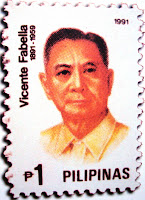Josefa Llanes Escoda on Stamps

Josefa Llanes Escoda (September 20, 1898–c. January 6, 1945) was a well-known Filipino advocate of women's right of suffrage and founder of the Girl Scouts of the Philippines.
Escoda was born in Dingras, Ilocos Norte. She was the eldest of the seven children of Mercedes Madamba and Gabriel Llanes. She was valedictorian in grade school and salutatorian in high school in Ilocos Norte. She went to Philippine Normal School in Manila to earn her teaching degree, and graduated with honors in 1919. While working as a teacher, she earned a high school teachers certificate from the University of the Philippines in 1922.
After obtaining her teacher's certificate, she became a social worker for the Philippine Chapter of the American Red Cross (the Philippines was a colony of the United States at the time). The Red Cross granted her a scholarship to the United States, where she earned a masteral degree in Sociology.
During her first trip to the United States, while she was at the Women's International League for Peace (1925), she met Antonio Escoda, a reporter from the Philippine Press Bureau whom she later married. They had two children, Maria Theresa, and Antonio. Also in 1925, she received a Master's Degree in Social Work from Columbia University.
She returned to the United States again in 1933 to undergo training in Girl Scouting sponsored by the Boy Scouts of the Philippines. Afterwards, she returned to the Philippines to train young women to become Girl Scout leaders, then proceeded to organize the Girl Scouts of the Philippines. On May 26, 1940, President Manuel L. Quezon signed the charter of the Girl Scouts of the Philippines. Josefa became the group's first National Executive.
During World War II, Japanese forces invaded the Philippines. Escoda's husband was arrested in June 1944, and she was also arrested two months later, on August 27. She was imprisoned in Fort Santiago, the same prison as her husband, Colonel Antonio Escoda, who was executed in 1944, along with General Vicente Lim, who was imprisoned with him. She was last seen on January 6, 1945. She was then evidently taken and held in one of the buildings of Far Eastern University occupied by the Japanese. It is presumed that she was executed and buried in an unmarked grave in the La Loma Cemetery which Japanese forces used as an execution and burial ground for thousands of Filipinos who resisted the occupation.
The stamp above was issued on 1973.






